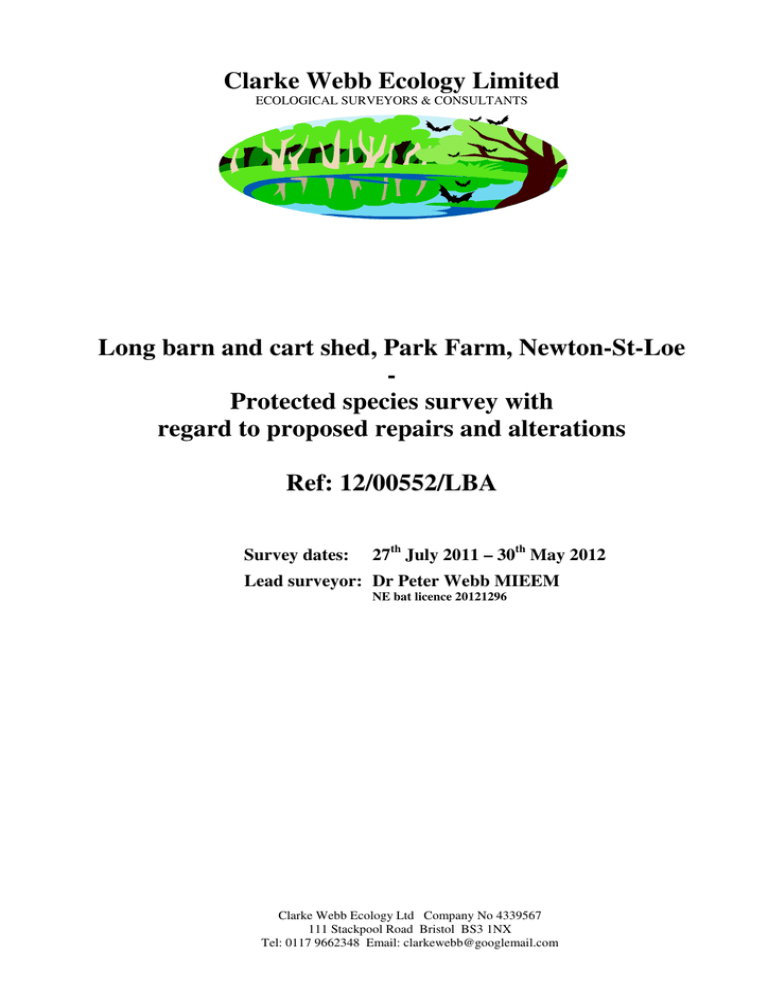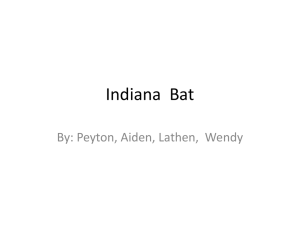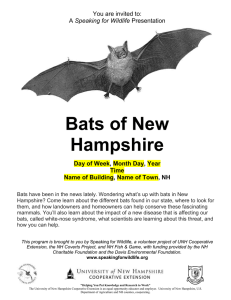Clarke Webb Ecology Limited Long barn and cart shed, Park Farm
advertisement

Clarke Webb Ecology Limited ECOLOGICAL SURVEYORS & CONSULTANTS Long barn and cart shed, Park Farm, Newton-St-Loe Protected species survey with regard to proposed repairs and alterations Ref: 12/00552/LBA Survey dates: 27th July 2011 – 30th May 2012 Lead surveyor: Dr Peter Webb MIEEM NE bat licence 20121296 Clarke Webb Ecology Ltd Company No 4339567 111 Stackpool Road Bristol BS3 1NX Tel: 0117 9662348 Email: clarkewebb@googlemail.com CLARKE WEBB ECOLOGY LTD Park Farm barns 1 Background and site description 1.1 This survey relates to proposed repairs to be carried out to two tradition stone outbuildings at Park Farm, Newton St Loe. 1.2 A site showing the location of the buildings can be found at Figure 1 with photographs at Figure 2. 1.3 Brief descriptions of the buildings are as follows: Long barn Large, stone threshing barn divisible into two rooms. Open to the roof which is timber-framed, double-pitched and fitted with clay tiles with a modern under-lay. Various open doorways permit flying access through out. Cart-shed Small, stone barn comprising a singe room, open at both gable ends. Open to the roof which is timber-framed, double-pitched and fitted with clay pan tiles with a bituminous felt under-lay. Currently supported by internal and external scaffold. Tatty, loose timber fascias are present around the eaves. Lean-to 1.4 Stone-built, single-storey lean to linking the Cart Shed with a stone Stable to the north. The roof is mono-pitched and fitted with double Roman clay tiles with a bituminous felt under-lay. Tile-work is tight. Stone and timber-work are generally sound. Fascias are lacking. There is normally no flying access. Details of the proposed works can be found elsewhere (namely Caroe & Partners Architects Drawing no. 1406/110 and Mann Williams Drawing no. 5419/004/P1) but essentially include: Long barn Removal of several small sections of concrete block work and reinstatement with stone; Repair/replacement of various doors; Installation of a slab threshold; Various other minor repairs/reinstatement of small sections of stone wall. Cart-shed Stitch repair several running cracks; Removal of cement mortar and replace with lime Otherwise repair existing lime mortar pointing; Rebuild stone piers Patch in new ends to timber rafters where rotten Move existing emergent flues from north face of roof to south face of adjacent lean-to. 1.5 The location is rural. Several adjacent modern farm buildings have been recently removed including one that abutted the northwest face of the Long barn. 2 Survey method 2.1 The buildings were searched by day on the 27th July 2011, 8th August 2011 and 30th May 2012 for any evidence of use by protected species liable to be affected by the proposed works. Daytime survey was supplemented by a single sunrise bat survey on the 8th August 2011. Survey included: p2/10 CLARKE WEBB ECOLOGY LTD Park Farm barns Bats – daytime survey and assessment 2.2 Affected parts of the two buildings (namely all walls, interior and roof timbers of the Cartshed, the interior and roof of the attached lean-to and targeted sections of wall – primarily around the two large, open doorways in the northwest face - on the Long barn were thoroughly searched for any sign of use by bats including: • the presence of bats within crevices; • bat droppings, urine stains or feeding remains on horizontal and vertical surfaces (eg floors, walls, foliage) within and around them; • any other sign of use by bats. Where appropriate, survey was aided by the use of binoculars, a powerful hand torch, an endoscope, a mechanics mirror, a penlight torch and a 5 m ladder. Bats - sunrise survey 2.3 The Cart-shed, lean-to and the northwest face of the Long barn were each watched by two surveyors for bats emerging entering or showing any particular interest in them over dawn on the 8th August 2011. The survey commenced approximately 120 minutes before sunrise and lasted for approximately 135 minutes. Surveyors were armed with broad-band and heterodyne bat detectors (Batbox Duet and Pettersson D240x) to aid in bat detection and species identification. Where appropriate sample time-expanded echolocation calls were recorded onto a Sony Walkman Minidisc player for later analysis. During the survey the surveyors continuously patrolled their survey areas (both inside and out where appropriate) ready to track bats back to any roosts within the buildings. Bats - other 2.4 Notwithstanding any of the above, areas of the buildings that will be affected by the proposed works were assessed as to their potential to house roosts that may not have been apparent during the survey. Barn owl 2.5 The buildings were searched for any sign of use by barn or other owls including the presence of owls themselves, their feathers, pellets or any other sign. Nesting birds 2.6 A check was made for sign of birds having nested recently within or upon the buildings. Other species 2.7 Any other sign of use or likely use of the buildings by protected species and/or the presence of immediately adjacent habitats with a reasonable potential to support protected species was noted. p3/10 CLARKE WEBB ECOLOGY LTD Park Farm barns 3 Results Bats – Daytime survey of Long Barn 3.1 There are a small number of crevices within or around external stone or block work around the two large doorways in the northwest face of the building (where the bulk of works will be targeted). These crevices tend not to progress and no evidence could be found for use of them by bats (despite thoroughly checking them on three separate days with the aid of a torch and endoscope). Internal stone and block-work local to the proposed works is generally sound. 3.2 Notwithstanding the above, we note that until recently this face was largely obscured by an abutting modern farm building. During a combined evening emergence and sunrise survey carried out on the 30th September/1st October 2010 prior to the demolition of the modern building a single soprano pipistrelle bat was noted probably returning to a roost below a roof tile in the northern corner of the Long barn. Bats – daytime survey of the Cart Shed 3.3 There are a moderate number of crevices within both internal and external stone-work. However, these crevices tend to be relatively shallow (ie not to progress) and relatively exposed (the building is small and open at both ends). No evidence was found for use of any such crevices by bats during the two daytime surveys. 3.4 There are numerous gaps between overlying clay tiles on the roof and a small number of gaps along the sides of the concrete ridge. There are also non-progressive running gaps behind some of the timber fascias. Bats – daytime survey of the lean-to 3.5 No evidence was found for use or likely use of the lean-to by bats. We note that roof tiles generally lie flush against one-another, stone and timber-work are generally sound. There are no fascias and no flying access under normal circumstances. Bats –sunrise survey 3.6 At the start of the sunrise survey air temperature was 12 oC, cloud cover was 80% and wind strength measured 2 on the Beaufort Scale. No rain fell during the survey. 3.7 Local bat activity during the sunrise survey was limited to a single local (but faint) pass by a common pipistrelle bat approximately 60 minutes before sunrise. No bats were noted flying within, entering or showing any particular interest in any of the buildings. Barn owl 3.8 No evidence was found for use of any of the buildings by barn owls. Nesting birds 3.9 In May 2012 a feral pigeon was noted nesting with the rafters of the Long Barn while a blue tit was seen to emerge from below a roof tile on the Cart Shed (though the presence of a nest could not be confirmed). No other evidence was found for current or recent use of any of the buildings by birds for nesting. p4/10 CLARKE WEBB ECOLOGY LTD Park Farm barns Other 3.10 No other evidence was found for use or likely use of the buildings or immediately adjacent land by protected species. 4 Interpretation and recommendations Bats 4.1 No evidence was found for the presence or likely presence of bat roosts likely to be affected by the proposed works. 4.2 Notwithstanding the above, we note that crevices in stone work such as those found in the Long Barn and the Cart Shed and various gaps between overlying roof tiles and/or along the ridge or behind some of the loose fascias on the Cart Shed are potentially suitable for use as roosts by individual (or possibly small numbers of) bats and that such bats are often relatively itinerant. One off or occasional use such as the above may not necessarily have been apparent during the survey. 4.3 It is an offence to damage, destroy or block access to a bat roost (‘place used for shelter, rest or protection’) or to cause significant disturbance to bats while they are within a roost. However, Natural England can issue licences permitting such actions provided certain conditions are met. Notwithstanding the above, the presence of bats is a material in the consideration of any application for planning or listed building consent. Planning Authorities must ensure that any consent they grant will not have an adverse impact on local populations of bats. 4.4 Given the lack of evidence for use of affected parts of the buildings by bats, the relatively low potential of affected parts of buildings for use by bats as roosts, the limited nature of the proposed works and that the buildings will be retained largely as is, we are of the opinion that survey has been sufficient to confirm that the proposals will not have an adverse impact on local populations of bats or otherwise result in an offence with regard to bats provided the following mitigation is adopted: i. all crevices in stone or block-work are checked with a torch for the presence of bats immediately prior to dismantling, filling or blocking them; ii. should there be a need to remove the roof (or significant parts of it) from the Cart Shed then: a) removal of roof and ridge tiles will occur carefully by hand either sometime between September and March inclusive or otherwise only immediately following an evening emergence and/or sunrise bats survey to confirm that no bats are present within it at the time; b) on reinstatement of the roof, tiles will be laid in such a way as to leave (as currently present) significant numbers of gaps (nominally around 20 mm high by 50 mm wide) between them such that bats can land on the surrounding tiles and crawl up through the gaps into natural crevices between tiles and underlay; c) at least 3 gaps suitable for use as roosts by bats will be left along the sides of the ridge (see Figure 3). ii. should bats be found within the buildings at any time then all works liable to impact upon them or their roosts will cease pending consultation with Natural England or some other p5/10 CLARKE WEBB ECOLOGY LTD Park Farm barns suitably qualified person as to how and when best to proceed. Bats will be left to disperse of their own accord. Nesting birds 4.5 It is an offence to damage or destroy the nest of any wild bird while that nest is being built or in use. Should birds commence nesting upon or within the buildings at any time then all works liable to impact upon those nests should be delayed until they are no longer occupied. Other 4.6 No evidence was found for significant use, or likely significant use, of the buildings or immediately adjacent land by any other protected species. 4.7 Notwithstanding the above, we see no need for any further ecological survey in relation to the proposed works. Disclaimer. All reasonable effort was taken to ensure an accurate assessment of the situation at the time of the survey. However, the absence of recorded sign should not be taken as an absolute guarantee that the site was not being used by a particular species. There is also no guarantee that any particular species will not use the site at any time in the future. Survey results may be weather or seasonally dependent. p6/10 CLARKE WEBB ECOLOGY LTD Park Farm barns Figure 1. Site plan showing the location of the two buildings Based on a reproduction from the Ordnance Survey under licence no: 100041216) p7/10 CLARKE WEBB ECOLOGY LTD Park Farm barns Figure 2. Photographs. P1. The Long barn as seen from the north. P2. One of the doorways on the Long barn around which works will be focussed. Note the sections of concrete blockwork to be replaced. P3. The interior of the Long barn. There is a reasonable chance of individual or small numbers of bats at least occasionally roosting within various crevices (eg in the roof) but the limited nature of the proposed works is unlikely to have any determinable impact upon them. P4. The Cart-shed as seen from the west. p8/10 CLARKE WEBB ECOLOGY LTD Park Farm barns P5. The northeast end of the Cart shed with the lean-to visible on the left. P6. Indicative part of one of the internal walls of the Cart shed. P7. The valley between the roofs of the Cart shed on the left and the lean-to on the right. The two visible flues will be moved from one roof to the other. p9/10 CLARKE WEBB ECOLOGY LTD Park Farm barns Figure 3. Indicative sketch of options for allowing bats crawling access into crevices within a tiled ridge. Not to scale. Roosts should be such that bats can land on the underlying roof tiles, crawl up through a gap on one side of the ridge (created by raising individual ridge tiles slightly above the ridge line, omitting bedding mortar, modifying ridge ventilation tiles etc) and from there into a crevice that extends sideways between adjacent ridge tiles and underlying felt or timbers. p10/10

